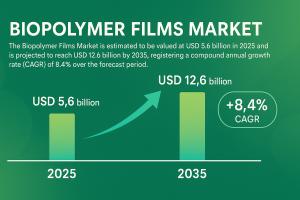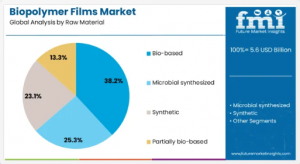Biopolymer Films Market to Hit USD 12.6 Billion by 2035, Boosting Sustainability While Tackling Manufacturing Hurdles
Biopolymer films hit USD 12.6 billion by 2035 at 8.4% CAGR, driven by bio-based materials, multilayer tech & demand for sustainable, high-performance packaging
NEWARK, DE, UNITED STATES, August 8, 2025 /EINPresswire.com/ -- The biopolymer films market is poised for a significant transformation, offering a clear growth trajectory for manufacturers navigating the complexities of sustainability, regulatory compliance, and consumer preference. A new market analysis reveals the sector, valued at USD 5.6 billion in 2025, is projected to reach an impressive USD 12.6 billion by 2035. This robust expansion, registering a compound annual growth rate (CAGR) of 8.4%, is not merely a market forecast; it is a blueprint for how packaging and materials manufacturers can future-proof their operations and capture a growing segment of the global economy.
Navigating Market Drivers and Future Growth
The report, "Biopolymer Films Market Size and Share Forecast Outlook 2025 to 2035," highlights that this growth is rooted in a compelling convergence of factors. Increasing environmental regulations and a global push to curb plastic pollution are no longer just external pressures; they are foundational market drivers. Companies that proactively shift to bio-based raw materials are not only meeting compliance requirements but are also gaining a significant competitive advantage. This strategic pivot is especially critical for those in the food and beverage, home and personal care, and pharmaceutical sectors, where the demand for sustainable, high-performance packaging is at an all-time high.
Key Segments Driving Innovation
A deeper dive into the market dynamics reveals that the key to unlocking this growth lies in two primary areas: material innovation and technological advancement. The bio-based raw material segment is the market leader, projected to account for 38.2% of the market revenue in 2025. This dominance is a direct result of the growing availability of renewable feedstocks like corn starch and cellulose, which provide a lower carbon footprint alternative to traditional plastics. For manufacturers, this represents a significant opportunity to streamline supply chains and invest in materials that are both environmentally friendly and economically viable.
Complementing this material shift is the rise of multilayer technology, which is expected to hold 34.6% of the technology market revenue in 2025. This technology is a game-changer, allowing manufacturers to overcome historical limitations of biopolymers. By combining different bio-based polymers, multilayer films can be engineered to deliver superior mechanical strength, durability, and essential barrier properties—critical for applications like food packaging where product integrity is paramount. This advancement directly addresses a core challenge for manufacturers: creating sustainable films that do not compromise on performance or cost-effectiveness.
Polylactic acid (PLA) film is at the forefront of this product evolution, projected to capture a commanding 41.9% of the market revenue in 2025. Derived from renewable resources, PLA films offer a powerful combination of clarity, printability, and compostability. Its widespread adoption, particularly in food packaging, is a testament to its versatility and its ability to meet both functional requirements and evolving consumer expectations for eco-friendly products.
Regional Hotspots and Global Momentum
The market's rapid expansion is not uniform, with specific regions showing exceptional growth potential. China and India lead the charge with CAGRs of 11.3% and 10.5%, respectively. This acceleration is driven by aggressive national policies and strong government support for biodegradable packaging, coupled with a booming e-commerce and retail sector. These regions are creating localized production hubs and offering incentives that are attracting significant investment in sustainable material innovation. Similarly, Germany and the UK are experiencing strong growth, fueled by stringent EU circular economy policies and partnerships between major consumer brands and biopolymer film producers. The United States, while growing at a tempered 7.1% CAGR, is seeing growth driven by state-level mandates and corporate sustainability commitments from large-scale retailers and quick-service restaurant chains.
Competitive Landscape and Key Developments
Leading players in the market are already demonstrating the path forward. Companies such as NatureWorks LLC, BASF SE, and Braskem SA are investing heavily in high-performance PLA and bio-polyethylene solutions. Innovators like Avery Dennison Corporation and Taghleef Industries are focusing on specialty films and labels, while Mondi Group and Amcor Ltd. are leveraging their global reach to integrate recyclable barrier coatings. The competitive landscape is defined by a commitment to aligning production strategies with regulatory frameworks and expanding capacity to meet the surge in demand.
A prime example of this forward-thinking strategy is the recent development in April 2024, where NatureWorks and IMA Coffee launched a full turnkey compostable coffee pod solution. This innovation, made from Ingeo™ PLA, addresses a specific, high-volume market need and demonstrates how strategic collaboration can create a viable, sustainable alternative to conventional packaging, even at high production speeds.
Request Biopolymer Films Market Draft Report: https://www.futuremarketinsights.com/reports/sample/rep-gb-22689
For more on their methodology and market coverage, visit! https://www.futuremarketinsights.com/about-us
Ultimately, the biopolymer films market is not just about a future projection; it is a present-day opportunity. For manufacturers, this market offers a definitive solution to some of their most pressing challenges: how to comply with regulations, satisfy consumer demand for sustainability, and invest in technologies that offer both environmental benefits and superior product performance. The clear growth trajectory, technological advancements, and supportive regulatory environment across key global regions provide a compelling case for manufacturers to accelerate their transition to biopolymer films, positioning themselves for sustained success and leadership in a more sustainable world.
Related Reports:
Inkjet Printers Market: https://www.futuremarketinsights.com/reports/inkjet-printers-market
Metallized Films Market: https://www.futuremarketinsights.com/reports/metalized-films-market
Heavy Duty Bags & Sacks Market: https://www.futuremarketinsights.com/reports/heavy-duty-bags-and-sacks-market
Editor’s Note:
This release is based exclusively on verified and factual market content derived from industry analysis by Future Market Insights. No AI-generated statistics or speculative data have been introduced. This press release highlights significant shifts in the Biopolymer Films Market, which is experiencing a pivotal change driven by consumer demand for healthier, more transparent products.
Rahul Singh
Future Market Insights Inc.
+18455795705 ext.
email us here
Visit us on social media:
Other
Legal Disclaimer:
EIN Presswire provides this news content "as is" without warranty of any kind. We do not accept any responsibility or liability for the accuracy, content, images, videos, licenses, completeness, legality, or reliability of the information contained in this article. If you have any complaints or copyright issues related to this article, kindly contact the author above.


